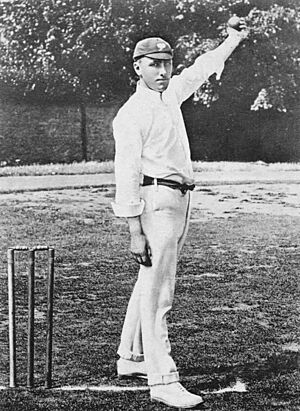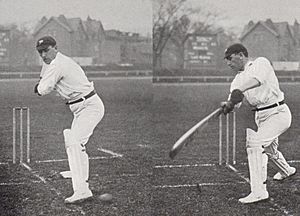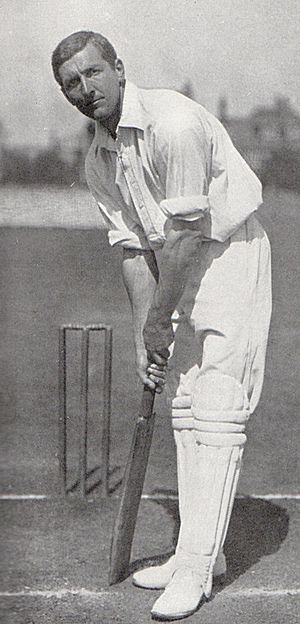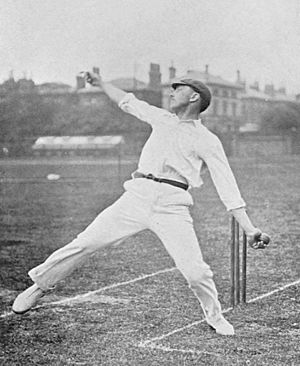Wilfred Rhodes facts for kids
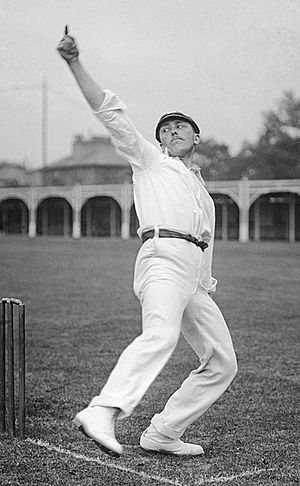
Wilfred Rhodes bowling in a photograph taken by George Beldam in 1906
|
||||||||||||||||||||||||||||||||||||||||
| Personal information | ||||||||||||||||||||||||||||||||||||||||
|---|---|---|---|---|---|---|---|---|---|---|---|---|---|---|---|---|---|---|---|---|---|---|---|---|---|---|---|---|---|---|---|---|---|---|---|---|---|---|---|---|
| Full name |
Wilfred Rhodes
|
|||||||||||||||||||||||||||||||||||||||
| Born | 29 October 1877 Kirkheaton, Yorkshire, England |
|||||||||||||||||||||||||||||||||||||||
| Died | 8 July 1973 (aged 95) Poole, Dorset, England |
|||||||||||||||||||||||||||||||||||||||
| Batting | Right-handed | |||||||||||||||||||||||||||||||||||||||
| Bowling | Slow left-arm orthodox | |||||||||||||||||||||||||||||||||||||||
| Role | All-rounder | |||||||||||||||||||||||||||||||||||||||
| International information | ||||||||||||||||||||||||||||||||||||||||
| National side |
|
|||||||||||||||||||||||||||||||||||||||
| Test debut (cap 121) | 1 June 1899 v Australia | |||||||||||||||||||||||||||||||||||||||
| Last Test | 3 April 1930 v West Indies | |||||||||||||||||||||||||||||||||||||||
| Domestic team information | ||||||||||||||||||||||||||||||||||||||||
| Years | Team | |||||||||||||||||||||||||||||||||||||||
| 1898–1930 | Yorkshire | |||||||||||||||||||||||||||||||||||||||
| Career statistics | ||||||||||||||||||||||||||||||||||||||||
|
||||||||||||||||||||||||||||||||||||||||
|
Source: ESPNcricinfo, 17 August 2007
|
||||||||||||||||||||||||||||||||||||||||
Wilfred Rhodes (born October 29, 1877 – died July 8, 1973) was a famous English cricket player. He played 58 Test matches for the England team between 1899 and 1930. In these matches, Rhodes took 127 wickets and scored 2,325 runs. He was the first English player to achieve both 1,000 runs and 100 wickets in Test matches.
Rhodes holds world records for playing the most first-class cricket matches (1,110 games) and taking the most wickets (4,204). He also achieved the "double" (1,000 runs and 100 wickets in a season) a record 16 times in English cricket. He played for Yorkshire and England until he was in his fifties. In his last Test match in 1930, he was 52 years and 165 days old, making him the oldest player ever in a Test match.
Rhodes started his career in 1898 as a slow left-arm bowler who could also bat well. He quickly became known as one of the best slow bowlers in the world. Before World War I, he improved his batting so much that he became one of England's top batsmen. He formed a strong opening partnership with Jack Hobbs. After the war, he returned to being a main bowler. He played as an all-rounder throughout the 1920s. He retired after the 1930 cricket season.
His first game for England was in 1899. He played regularly until 1921. In 1926, at age 48, he was called back for the final Ashes Test. He helped England win the match and get back the Ashes for the first time since 1912. He finished his Test career in the West Indies in April 1930.
As a bowler, Rhodes was known for his amazing accuracy and ability to make the ball change direction. He was especially good on wet pitches, where he could get many players out quickly. His batting was steady and reliable, but not flashy. After he stopped playing, he coached at Harrow School. His eyesight began to get worse around 1939, and he became completely blind by 1952. He was a respected figure in cricket until he passed away in 1973.
Contents
Early Life and Cricket Career
Starting Out in Cricket
Wilfred Rhodes was born in 1877 in Kirkheaton, a village near Huddersfield. His family moved to a farm when he was very young. He went to school in Hopton and later in Huddersfield. His father, Alfred Rhodes, was a cricket captain and encouraged Wilfred to play. He even bought him equipment and made a practice pitch near their home.
When Rhodes left school at 16, he joined Kirkheaton Cricket Club. He started to take cricket seriously. He watched the Yorkshire team play and thought about becoming a professional cricketer. Around 1893, he worked on the railway in Mirfield. One day, he rang the off-duty bell early to get to a game, and he lost his job. After that, he worked on a farm, which gave him more time for cricket. By 1895, he was playing for the Kirkheaton first team. He was then recommended to Gala Cricket Club in Galashiels, Scotland, as a professional player.
Playing for Clubs
Rhodes played for Gala Cricket Club in 1896 and 1897. He was an all-rounder, meaning he was good at both batting and bowling. He opened the batting and bowled medium-paced seamers. In his first season, he took 92 wickets. He found that bowling an occasional slow ball worked well. He decided to change his bowling style to spin. He spent the winter of 1896–97 practicing on the family farm. He also worked as a signalman on the railway again.
For several months, Rhodes practiced to control his spin and different types of deliveries. In his second season at Galashiels, he bowled slow left-arm spin. He took fewer wickets but at a better average. At the end of 1897, he left Gala to find work in England.
Becoming a First-Class Cricketer
Beginning as a Bowler
Rhodes tried to join the Warwickshire County Cricket Club, but they couldn't hire him. At this time, Yorkshire was looking for a slow left-arm spinner to replace Bobby Peel. Rhodes tried out for a Yorkshire team against the County XI. He later said he played poorly, while another player, Albert Cordingley, took nine wickets.
In spring 1898, Rhodes was invited to practice at Headingley. This led to him playing in some unofficial matches. Rhodes made his first-class debut for Yorkshire on May 12, 1898, against the MCC. He took six wickets in that match. In his second game, he played his first County Championship match against Somerset. He took 13 wickets for only 45 runs.
In the 1898 season, Wisden Cricketers' Almanack said Rhodes "sprang at once into fame." He bowled with amazing success. By the end of the season, he had taken 154 wickets at an average of 14.60. He was named one of the Wisden Cricketers of the Year for 1899. Wisden said his skills as a slow bowler were "exceptional." He also scored three half-centuries as a batsman. By the end of the season, he was considered the best left-arm spinner in England.
In 1899, Rhodes took 179 wickets. The weather was dry, making pitches harder and better for batting. Wisden still called him "head and shoulders above his colleagues." He made his Test debut in the series against Australia. He played in three of the five Tests. His first Test was also W. G. Grace's last. His teammates included famous players like C. B. Fry and George Hirst. Rhodes opened the bowling for England and took four wickets for 58 runs. He finished the series with 13 wickets.
Rhodes's most successful years for taking wickets were from 1900 to 1902. In these three years, he took 725 wickets. He took five or more wickets in an innings 68 times. He also took ten or more wickets in a match 21 times. This helped Yorkshire win three County Championships in a row. In 1900, he took 261 wickets. In 1901, he took 251 wickets, which Wisden called "astonishing." He also scored his first first-class century that year. In 1902, he took 213 wickets.
The main cricket event of 1902 was the Australian tour of England. Rhodes played in all five Tests. He was England's top wicket-taker with 22 wickets. He took seven wickets for 17 runs in the first innings of the first Test. In the fourth Test, Rhodes took seven wickets. In the final Test, at The Oval, England needed 263 runs to win. Rhodes came in to bat when the ninth wicket fell, with 15 runs still needed. He and Hirst stayed together, and England won by one wicket.
In 1903, Rhodes scored over 1,000 runs for the first time. He also completed his first "double" (1,000 runs and 100 wickets).
From Bowler to All-Rounder
Pelham Warner, a leading amateur cricketer, chose Rhodes for the first MCC tour of Australia in 1903–04. Warner called Rhodes the "mainstay of the team." Wisden said he proved critics wrong and was the most effective bowler on the tour. He took 65 first-class wickets and 31 Test wickets.
England won the Test series 3–2. In the first match, Rhodes scored 40 runs. He helped R. E. Foster add 130 runs for the tenth wicket. This was a Test record partnership for 70 years. In the second Test, Rhodes took 15 wickets for 124 runs. This was the best bowling performance in a match between England and Australia until 1934. His eight wickets for 68 runs in the second innings remained his best Test figures.
Rhodes felt the 1903–04 tour changed his bowling. He started bowling faster in Australia and continued this style in England. He also spent more time on his batting, which he thought affected his bowling. He started scoring more runs and moved higher up the batting order. His bowling slowly declined until World War I.
In 1904, Rhodes took 131 wickets, his lowest total so far. But he scored 1,537 runs, including two centuries. He completed his second double. In 1905, Yorkshire won the Championship. Rhodes completed another double with 1,581 runs and 182 wickets. He played in four of the five Tests against Australia. England won the series 2–0. Rhodes scored 146 runs and took ten wickets.
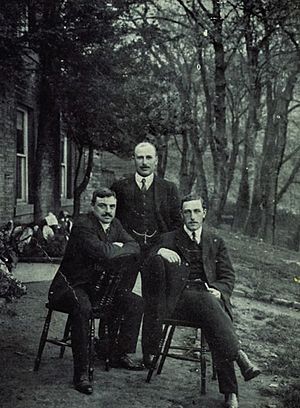
Rhodes's bowling continued to decline in 1906. Wisden said he had lost his sharp spin. He scored 1,721 runs, often opening the batting, and took 128 wickets. In 1907, he took more wickets (173) and scored 1,045 runs, completing another double. He became Yorkshire's permanent opening batsman.
Rhodes and Colin Blythe toured Australia in 1907–08. Rhodes was now seen mainly as a batsman. In the five-Test series, he scored 205 runs, including his first Test half-century. He took seven wickets. He followed this with another double in 1908, scoring 1,660 runs and taking 106 wickets. Yorkshire won the County Championship.
In 1909, Rhodes scored 2,094 runs and took 141 wickets. Wisden said he had become "an exceptionally good batsman." He played in four of the five Tests against Australia. He scored 168 runs and took 11 wickets. In the final Test, he scored two half-centuries (66 and 54) and helped save the game.
Opening Batsman with Jack Hobbs
In the 1909–10 English winter, MCC toured South Africa. Rhodes opened the batting with Jack Hobbs for the first time. In the Test series, which South Africa won 3–2, Rhodes took only two wickets. But he formed strong partnerships with Hobbs. In the first Test, they put on 159 runs together, with Rhodes scoring 66. In the final Test, they scored 221 runs, with Rhodes making his highest Test score at the time, 77. Rhodes and Hobbs developed a great understanding while batting, often scoring runs without needing to call out to each other.
In 1910, Rhodes was less successful with both bat and ball. Yorkshire finished eighth in the County Championship. In 1911, which was a dry summer, Rhodes scored 2,261 runs, his highest season total. He also took 117 wickets. He received a benefit match against Lancashire, earning £750.
Batting Success in Australia
In September 1911, Rhodes visited Australia again, opening the batting with Jack Hobbs. This tour was the peak of his batting success. Under captain Johnny Douglas, England won the 1911–12 Test series against Australia 4–1. Their success was largely due to Hobbs and Rhodes as opening batsmen.
In the first Test, Rhodes scored 41. In the second match, he scored 61, passing 1,000 Test career runs. In the third Test, he scored 59. In the fourth Test, which England won easily, Rhodes scored 179. He and Hobbs set a Test record partnership of 323 runs for the first wicket. This was Rhodes's first Test century and his highest Test score. Wisden called his seven-hour innings "a remarkable display of careful batting." In the final Test, Rhodes scored 76 with Hobbs. He finished the series with 463 runs at an average of 57.87, his best series average. On the whole tour, he scored 1,098 runs but did not take a single first-class wicket.
Triangular Tournament
In the 1912 season, England, captained by C. B. Fry, played in the first-ever triangular Test tournament against Australia and South Africa. The weather was very wet, and the South African team was weak. Rhodes played as Hobbs' opening partner in all six of England's matches.
In England's first win against South Africa, Rhodes scored 36. In a drawn game against Australia, Hobbs and Rhodes scored 112 for the first wicket. Rhodes scored 59. Later, he took three wickets for 59, his only wickets in the tournament. In a rain-affected game against Australia, Rhodes scored 92. In the final match against Australia, Rhodes scored 49 in an opening stand of 107 with Hobbs. England won the match and the tournament. Rhodes scored 204 runs against Australia but only 53 runs against South Africa. In all first-class matches that summer, he scored 1,576 runs and took 53 wickets, his lowest wicket total in an English season.
Last Seasons Before the War
In 1913, Rhodes scored 1,963 runs and took 86 wickets. In the 1913–14 English winter, Rhodes went to South Africa with the MCC. England won the series 4–0. Rhodes scored 731 runs and took 31 wickets. Wisden praised his value as an all-rounder. In the second Test, Rhodes took his 100th Test wicket. He also completed the double of 1,000 runs and 100 wickets in Tests, becoming the first England player to do so. In the same match, Rhodes scored his second and final Test century, 152 runs. He batted for over five hours. In all Tests on the tour, Rhodes scored 289 runs and took six wickets.
In the last season before World War I, Rhodes scored 1,377 runs. Yorkshire used him more as a bowler, and he took 118 wickets, completing another double. When war broke out in August 1914, first-class cricket stopped. Rhodes worked in a munitions factory in Huddersfield.
Career After World War I
Becoming a Leading Bowler Again
When cricket started again in 1919, county matches were shortened to two days. Critics and players found this difficult. Yorkshire won the championship with a new team. Their bowling attack was weaker. Rhodes decided to become a full-time bowler again. He practiced more, took more wickets, and regained his confidence. He bowled very accurately and used his experience well.
Because Percy Holmes and Herbert Sutcliffe were successful opening batsmen, Rhodes moved down the batting order to number four. He scored 1,237 runs and took 164 wickets, finishing as the top first-class bowler. In the following season, Rhodes scored 1,123 runs and took 161 wickets. He was chosen to go to Australia with the 1920–21 MCC touring team.
Australian Tour, 1920–21
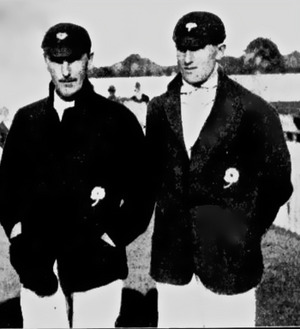
The English team that toured Australia was weak in bowling. Australia was much stronger, and England lost all five Test matches. This was a "disaster" according to Wisden. Rhodes played for Yorkshire as a middle-order batsman and main bowler. But England's captain, Douglas, was unsure how to use him.
On the tour, Rhodes scored two centuries, including a double-century. He totaled 730 runs in all first-class matches. Although he was a top bowler in England, he bowled rarely and with little success in Australia. He took only 18 first-class wickets on the tour. In the Tests, Rhodes scored 238 runs. He took four Test wickets. Rhodes later said that Douglas didn't want to use his bowling, thinking it wouldn't work on Australian pitches.
Senior Professional Player
The 1921 season was a big change for Rhodes. His regular England career ended during the visit of the Australians. England lost the series. Rhodes played in the first Test, but was then dropped from the team for five years. It was thought he struggled against the fast bowling of Jack Gregory and Ted McDonald. Because of these problems, Rhodes changed his batting stance. He started using the "two-eyed stance," where he turned his body towards the bowler. Critics thought this looked ugly and limited his shots.
In 1921, Rhodes scored 1,474 runs, including his highest first-class score of 267 not out. He also took 141 wickets. In the autumn, he traveled to India to coach and play. He did this every year until 1927.
From 1922 to 1925, Yorkshire won the County Championship every year. Rhodes scored over 1,000 runs each year. He was usually the fourth or fifth bowler used. He bowled accurately and placed fielders well to stop batsmen from scoring. He took over 100 wickets in 1922, 1923, and 1924. As Yorkshire's senior professional, Rhodes was very important. He helped the team's tactics and improved their fielding. He was very influential, sometimes even arranging fielders without directly asking the captain.
Recalled for the Oval Match
In 1925, Wisden noted Rhodes's age and reduced performance. But in 1926, Wisden reported that Rhodes was in "wonderful form" despite his age. He doubled his wicket count from 1925, taking 115 wickets. He also scored 1,132 runs, the last time he passed 1,000 runs in a season. He completed his 16th and final double.
In 1926, the Australians toured England. Rhodes was chosen to be on the selection committee. The English selectors tried to get him to play for England, but he refused, saying younger players should be chosen. The first four Tests were drawn. For the final Test at the Oval, England needed to win to regain the Ashes. The selectors dropped the captain and recalled Rhodes, who was nearly 49. Wisden said his selection was a "surprise."
England batted first and scored 280. Rhodes scored 28. Australia scored 302. Rhodes bowled 25 overs and took two wickets for 35 runs. He felt nervous at first but was encouraged by the crowd. Overnight rain made the pitch very difficult to bat on for England's second innings. However, Hobbs and Sutcliffe scored 172 runs for the first wicket. England scored 436, leaving Australia to chase 415. Rhodes quickly started taking wickets, taking four for 44. Australia was bowled out for 125. England won the series and the Ashes. Wisden said Rhodes's selection was "crowned with complete success."
Later Career and Retirement
Rhodes continued to play for Yorkshire until 1930. He scored only one more century, in 1928. He took 85 wickets in 1927, 115 in 1928, and 100 in 1929. In 1927, Yorkshire started a public collection for Rhodes, which raised £1,821. On July 23, 1927, he played his 1,000th first-class match. He is the only cricketer to have played so many first-class matches. On May 10, 1929, he became the first, and only, man to take 4,000 first-class wickets.
In 1929–30, Rhodes was chosen for an MCC team to tour the West Indies. He called it an "old crocks" team. He took 39 first-class wickets and scored 129 runs. In the four Test matches, Rhodes took ten wickets. On April 12, 1930, the last day of the final Test, Rhodes was 52 years and 165 days old. This made him the oldest-ever Test cricketer.
During the 1930 season, Rhodes announced he would retire. He found it harder to take wickets, and the heavy workload in the West Indies had made him less enthusiastic. He accepted a job as a cricket coach at Harrow School. Rhodes missed some matches at the end of the 1930 season. His last match was for H. D. G. Leveson Gower's XI against the Australians. He took five wickets for 93 runs, taking a wicket with his last ball in first-class cricket. In his final season, he took 73 wickets and scored 478 runs.
Over his career, Rhodes played in 1,110 first-class matches, which is a world record. He scored 39,969 runs, one of the highest totals ever. He also took 4,204 wickets, a record in first-class cricket. In his 58 Tests, Rhodes scored 2,325 runs and took 127 wickets. He was the first player in the world to get 2,000 runs and 100 wickets in Tests.
Rhodes coached at Harrow School until 1936. He had a lot of technical knowledge about cricket. However, he was very critical, and this didn't work well with the schoolboys. He was replaced by a more friendly coach.
Playing Style and Personality
As a bowler, Rhodes is considered one of the greatest slow bowlers of all time. He was very good at getting batsmen out on difficult pitches. It was hard to score runs off his bowling, even on good batting surfaces. He could make the ball spin a lot, especially on wet pitches. He had a smooth and accurate bowling action. He was a master of spin and could also bowl balls that went straight. In his early years, he could spin the ball very sharply. Later, he became an expert at figuring out a batsman's weaknesses. He was also very good at "flighting" the ball, making it curve through the air to trick batsmen. His bowling partnership with George Hirst was very strong. As he got older, his accuracy became amazing, with every ball seeming to land in the same spot.
Rhodes said he preferred batting to bowling. He was a right-handed batsman with a good defensive technique. He was a strong hitter of the ball, especially early in his career. He was described as a "craftsman rather than an artist." He worked hard to become a good batsman. After changing to the "two-eyed stance," he scored more runs on the leg-side. A key part of his batting career was his successful opening partnership with Jack Hobbs. They were very good at running between the wickets. He scored over 190 runs in an innings five times. He also scored centuries in both innings of a match twice.
When Rhodes played, he was not always friendly. He could get annoyed on the field and was critical of others. He was described as a "dour, methodical and calculating cricketer." He was not as popular as George Hirst, but he earned a lot of respect. He was an introvert and rarely smiled in pictures. However, he became more relaxed later in life, especially after he lost his eyesight. His obituary in The Times said he was "a fighting Yorkshireman, superbly gifted."
Personal Life
In October 1899, Rhodes married Sarah Elizabeth Stancliffe. They lived in a farmhouse in Kirkheaton. On August 25, 1902, their only child, a daughter, was born. Rhodes felt that Yorkshire County Cricket Club was not generous with money. After his benefit match in 1911, Yorkshire kept most of the money to invest for him, only paying him the interest. Rhodes thought this was unfair. However, he used the money to build a stone house in Marsh, Huddersfield, where his family moved in 1912. He lived there until 1956.
Around 1936, Rhodes's eyesight began to fail. By 1939, he couldn't take a wartime job. He was diagnosed with glaucoma, but it was too late to do anything. He could still watch cricket and play golf, but by 1946, he couldn't read a newspaper. By 1952, Rhodes was completely blind. In 1958, his left eyeball had to be removed due to pain.
In 1950, Sarah Rhodes had a heart attack, which limited her ability to help her husband. She died in 1954, just before her 80th birthday. Rhodes then sold his house and moved in with his daughter and her husband. He continued to attend cricket matches and could follow the game despite being blind. Cricketers often sought his advice. He was given honorary life membership of Yorkshire in 1946 and of the Marylebone Cricket Club (MCC) in 1949. He died in 1973, at the age of 95.
In 2009, Rhodes was added to the ICC Cricket Hall of Fame.


